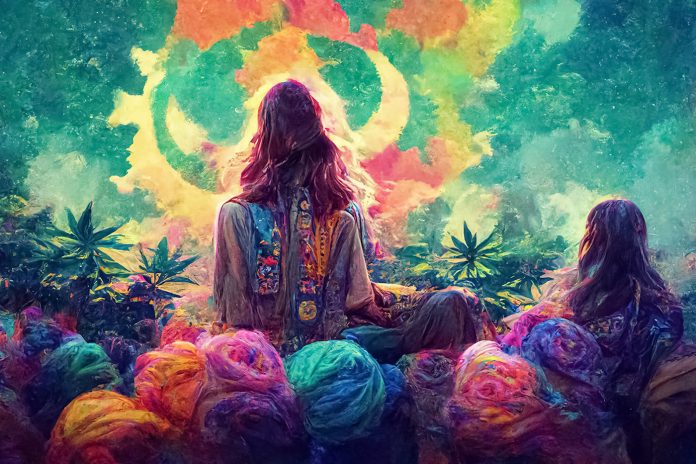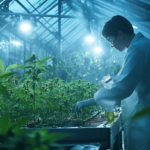One August not too long ago, I was in the English countryside in a little town called Kenilworth. I and several others from the international cannabis convention circuit had made a pilgrimage for the annual Product Earth Expo held at the National Agricultural and Exhibition Centre Stoneleigh in Warwickshire. On this beautiful summer evening, I sat around a table at The Queen & Castle Pub’s beautiful English garden with an excellent view of Leicester’s Gatehouse across the way. Next to me sat industry-turned-personal friends from around the world. The group included an Irishman from Cork, a Dutchman from Amsterdam, a Chilean from Santiago, and an Aussie from Rockhampton. Everyone had their drink of choice before them, eager to discuss the day.
A few things crossed my mind during this surreal moment. First, how fortunate I have been thanks to this phenomenal plant. Second, the fact that not a single individual had ordered a shot. And why would they? The attraction for most drinkers is to enjoy their beverage of choice. Sure, novice drinkers in their early years may aim to get sloshed as fast as possible, but the mainstream arguably enjoys the journey from sober to sozzled when consuming a libation.
With that in mind, why do we still fixate on buying and selling cannabis with the highest-possible THC numbers? This is a question many educated cannabis connoisseurs ask on a regular basis. While many in our industry avoid comparisons between alcohol and cannabis, it’s tough to avoid similarities or lack thereof when contemplating recreational-use scenarios. With alcohol prohibition ending ninety years ago, few remain living who can tell first-person stories from those times. One thing I found from that era is that bathtub gin did not prosper post-Prohibition. In fact, most of the spirits that became popular during Prohibition fell out of favor when “white lightning” and rum no longer were the only alcohol to be had. Beer and wine manufacturers came full stride after the Twenty-first Amendment was ratified in 1933. Literally, a team of Budweiser Clydesdales was sent to the White House to give President Roosevelt a ceremonial case of beer on April 7 of that year.
Yet here we are, more than a decade after Colorado legalized adult-use cannabis, and people still judge, price, and purchase flower based on the potency of a single cannabinoid: THC. In the early years, we often referred to the experience of cannabis as the “entourage effect.” Some initially used this term to describe the balance of THC and CBD, but most eventually came to use the phrase to describe a balance of cannabinoids and terpenes.
Those who study the plant have pushed to steer us away from our infatuation with the principal psychoactive constituent of cannabis. In recent years a new term has surfaced: the “concert effect.” What’s the difference? The term entourage evokes the idea of one key element or individual surrounded by or grouped with others. That, in itself, puts an excessive emphasis on THC. Concert effect, on the other hand, more fittingly describes the overarching experiential effect at the plant’s core: several instruments coming together to create cohesive harmony.
As a grower, my focus is not on THC potency. My goal is to create an environment that allows the genetics at hand to thrive and mature the way Mother Nature intended. As an outdoor grower, I embrace the phenotype expressed when the genotype in play interacts with the existing environment. Ultimately, this will yield a strong balance of terpenes and cannabinoids.
As a gearhead, I compare growing quality flower to building a car. I never focus on power or speed alone. What happens when life throws me a turn or unexpected obstacle? This is where better suspension and brakes come into play. Similar to a well-rounded car, the cannabis plant should be produced with the goal of maximizing synergy between every element. This ensures the best experience for the consumer.
Can we end the race to the top in THC today or tomorrow? Likely not. But an awakening must occur, and the cycle needs to break. Buyers should look for quality, consistency, and potency with regard to cannabinoids and terpenes, not just THC numbers, which marketers sometimes inflate. Retailers need to stop prioritizing THC and instead focus on well-crafted flower from growers with sustainable, organic, and healthy cultivation practices. When those selling products to the public are high-tolerance users themselves, how unbiased do we expect their recommendations to be? Our industry always will have consumers who care only about the cheapest buzz, but this isn’t true for everyone—especially first-time consumers, the fastest-growing market segment.
I believe this industry will see a gradual shift similar to what occurred in the alcohol industry. There will be a continental divide between mass-scale producers focused on margins and micro-growers focused on craft. Some will praise small-batch, high-quality cannabis from choice regions with terpene numbers that wow the connoisseur, while others will continue to seek an $80 ounce to get them through the next few days. Let’s hope the awakening occurs sooner rather than later. Those dictating the way the market works today are focused on the wrong thing: THC potency.
I vividly remember that day in the countryside for a specific reason: That was the day I decided I was over alcohol. While I never was a big drinker, I realized poison is not the best path to a buzz. I already had chosen cannabis and Eastern medicine over pharmaceuticals years earlier, and I felt the same ideology should carry over to the recreational side of life as well. Now, the hardest stuff in my cabinet is some rubbing alcohol I keep around for scratches, stickers, and my trimming scissors.














[…] states began legalizing the plant despite federal law, breeding programs shifted their focus toward maximizing THC content, prioritizing high-potency flower with appealing aesthetics. Intrepid breeders, limited by space […]
[…] behind high-quality concentrates with no residual solvents in the final product. Whether extracting THC, CBD oils, minor cannabinoids, or terpenes, there’s cannabis extraction equipment for any job and […]
[…] the matter told the Journal. Others within the agency reportedly are concerned about the increasing potency of THC and rescheduling’s potential impact on international treaties like the 1961 Single Convention on […]
[…] Cherry Gelato is recommended for more experienced consumers, often for its high THC content. For shops that tend to cater to high-dose consumers who prefer upbeat hybrids that simultaneously […]
[…] and efficacy of the industry. In a grow room, that looks like less labor, longer-lasting and more potent product, and more time and money for entrepreneurs to come up with better ideas for their […]
[…] with triploids? Are there other cannabinoids we haven’t even seen yet? Will we finally see that true 40-percent THC that isn’t just a fictitious lab fever […]
[…] said Inspired Cannabis co-founder and president Jesse Dhami. “All the other stores were offering the highest THC at the lowest price. We saw a gap in the market to celebrate great brands the same way liquor stores […]
[…] for popular foods that are appealing to children and can make it easy for a young child to ingest very high doses without realizing […]
[…] beverage alcohol instead. In that market, brand affinity, product quality, and overall experience, not potency, drive price. Anderson and Bullock also astutely observed American adults want to consume less […]
[…] popularity of autoflowers is growing rapidly—it seems to be growing in tandem with the THC content, which can reach the low-30s now,” said Ben Lind, chief science officer and co-founder at […]